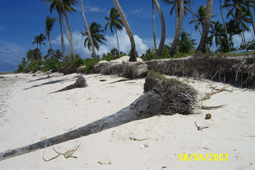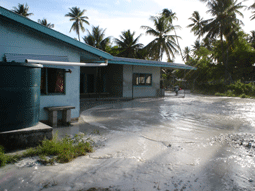 |

The Vanishing of a Tropical Nation
by Aaron Selverston

The islands of the Republic of Kiribati average only six feet above sea level. Here, Tarawa's lagoon comes right up to a residence. Photo: Oskar Garcia
From 10,000 feet above the Pacific Ocean, the tropical island of Tarawa resembles the vanishing stage of a waning moon; a razor thin crescent of shimmering green against a vastness of dark ocean. Its very existence seems accidental, precarious, as if a single thunderhead could wash it away.
Dropping to 1,000 feet, detail of a coconut grove emerges, a carpet of thick, green fans swaying against the wind. At 500 feet, closing in on the beach, a collection of thatch-hut dwellings appears near the shore. Down on the sand, a man is walking, contemplating how the shoreline has changed in the thirty years since he last came to this spot: the site of his childhood home. He stops in front of two cement blocks poking out of the sand.
"Yeah, this is the foundation of the house I grew up in," says Uentabo MacKenzie. "That used to be my playground. I remember playing soccer between the house and the trees way back there."
MacKenzie, an expert on the South Pacific who authored a World Bank report on the social impacts of climate change, says people all across this island nation, the Republic of Kiribati, are complaining of erosion.

A fallen coconut palm tree waits to be washed out to sea. Erosion in Bonriki, Republic of Kiribati, is pushing the shoreline back. Photo: Republic of Kiribati Ministry of Environment, Lands, and Agricultural Development
"This is serious. In terms of how people measure it, it has come to the second row of trees," he says as he points out to where the waves are crashing. "There used to be coconut right up to there, and big trees even further back than where the water is now. A lot of land has been eroded away. A good 50 meters - 50, 60 meters - is now under water. So I feel sad coming back to my old playground."
More of these difficult changes are likely for I-Kiribati, as people here call themselves. Climate scientists say coral atolls throughout the South Pacific could be the most susceptible areas in the world to the effects of global warming. The Intergovernmental Panel on Climate Change, a U.N.-sponsored group representing the scientific consensus on climate change, says that rising sea levels could cause not just erosion, but also flooding and salinization of soils and freshwater.
I-Kiribati from across the islands are already complaining of these problems. Some of what islanders are noticing now is probably locally caused. In his office, surrounded by stacks of academic journals, MacKenzie describes how concrete causeways that link islets together in Kiribati have led to erosion. Climate change will exacerbate these problems.
"I have no doubt that these islands will be inundated," says MacKenzie. "Or, if they're not inundated, the livelihood of people will be very difficult because it will affect saltwater incursion into our water tables, it will affect our plant-life, it will affect the water we drink."

A fallen coconut palm tree waits to be washed out to sea. Erosion in Bonriki, Republic of Kiribati, is pushing the shoreline back. Flooding in South Tarawa, Republic of Kiribati Photo: Alice Leney
"It's a humanitarian disaster. These people will lose their homes, their own nation. They'll end up moving at some point," says Rob Dunbar, professor of environmental and geologic sciences at Stanford University. He has spent the last 15 years studying climate in Kiribati. "When their government looks ahead, say, 100 years, 200 years, you know, there's a pretty good chance those islands won't even exist."
"It's seriously a matter of survival," says Kiribati President Anote Tong who devotes an increasing share of his time to these issues. He is just returning from the outer island of Butaritari. People there complained to him that taro pits have become flooded with saltwater. Taro is a root crop and staple food in the South Pacific.
"We can only adapt so far," says Tong. "For countries like Kiribati is that we may have already gone well beyond adaptation. Maybe we've reached the stage where very little can be done now to reverse the process."
We really cannot discuss issues like development if in the longer term we are facing an issue of survival. So no matter how much we develop over the next decades, if in 50 years time we're going to go under, what is the purpose of it all?
Back to Reports from a Warming Planet